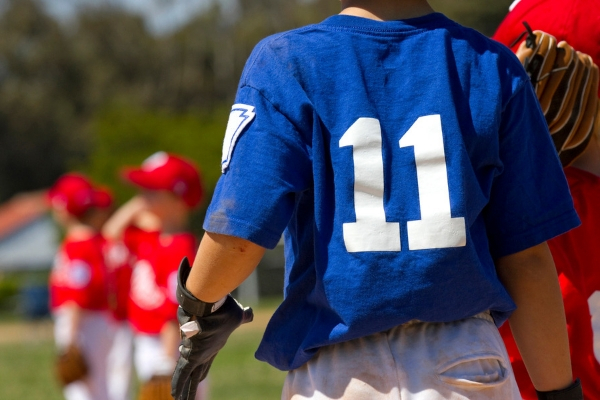As a mom of four boys, I am often worried about keeping my kids safe. My days are filled with the sounds of “Mom, watch this!” and “I didn’t do it!” I often feel like a referee breaking up fights or running to rescue someone off the trampoline. Their physical safety is constantly a concern in the back of mind and while I know their safety is mainly my responsibility now, one day soon it will be in the hands of others as they become more active in school and sports.

While my husband and I don’t come from strong sports families, it’s been shown time and again that athletics is an important part of a child’s growth and development so we’re encouraging our boys’ involvement as long as possible.
According to AtYourOwnRisk.org, students who participate in high school athletics are 15% more likely to attend college and maintain higher grades through high school and athletes are less likely to use drugs, smoke cigarettes or carry weapons.
Most importantly, student athletes tend to display stronger peer relationships, better attachment with adults, higher self-esteem, a closer sense of family, and participate more in volunteerism.
These key values and traits are why we spend our days shuffling kids to practices and spending our Saturdays cheering from the sidelines. And by sports, we’re not talking about football. (No Friday Night Lights for our family.) We’re actually encouraging our boys to explore all their athletic options; including soccer, baseball, basketball, tennis, and even taekwondo!
Whatever their passion or whichever sport they decide to pursue, I want to know that their safety is a priority to those we’re entrusting our children to. It’s my job as Mom to make sure they’re surrounded by trained professionals who will help ensure they’re learning and growing mentally and physically — while also having as few injuries as possible.
AtYourOwnRisk.org – a public campaign to educate and advocate for safety in work, life, and sports – states that 90% of student athletes report some sort of sports-related injury in their athletic careers.
While it’s understandable that injuries will happen, what’s even scarier is that —
- 54% of student athletes report they’ve played while injured
- 12% report they have sustained concussions and head injuries from their time on the field.
- Among children, those ages 15-17 experience the highest rate of emergency room visits for sports injuries.
- 62% of sports-related injuries happen during practice.
If coaches and administrators alone aren’t able to reduce the risk of injury for my child, the question is how can I ensure a healthier and safer environment for my child?
The public campaign, AtYourOwnRisk.org, helps families learn more about the role of athletic trainers in schools and how AT’s can help provide a variety of services for parents and athletes. A study from the American Academy of Pediatrics showed that the presence of athletic trainers can have a significant positive impact on student athlete health, resulting in lower injury rates, improved diagnosis and return-to-play decisions for concussion and other injuries.
 I recently met with Dallas Mavericks’ Head Athletic Trainer, Casey Smith, MS, ATC, LAT to discuss the imporance of athletic trainers in youth sports. As a member of the U.S. Olympic Committee and trainer for the USA Basketball Men’s National Team, he is considered to be the best athletic trainers in the NBA. I was honored that he was willing to walk us through the Dallas Mavericks athletic training facility and provide some background knowledge on the importance of his role when it comes to monitoring players’ health.
I recently met with Dallas Mavericks’ Head Athletic Trainer, Casey Smith, MS, ATC, LAT to discuss the imporance of athletic trainers in youth sports. As a member of the U.S. Olympic Committee and trainer for the USA Basketball Men’s National Team, he is considered to be the best athletic trainers in the NBA. I was honored that he was willing to walk us through the Dallas Mavericks athletic training facility and provide some background knowledge on the importance of his role when it comes to monitoring players’ health.
While Texas is one of the top leaders in recognizing the need for athletic trainers with over 63% employed at schools full-time, parents can work together to help secure an athletic trainer on their campuses here locally and across the state.
3 Reasons Your Campus Should Have An Athletic Trainer
Reduce the Risk of Injury
Did you know schools that have an athletic trainer report having fewer injuries to their athletes? An athletic trainer’s main role is to “provide medical care and supervision during games and practice, and develop injury prevention programs to keep athletes healthy and on the field.” As parents, we need to do the research and make sure our youth athletes have the safety support system in place to protect their bodies — and in severe cases, their lives.
Not All Injuries are Visible
Right now, it’s easy to tell when my young boys are hurt. Complaining, visual cues — and sometimes crying — all tell me something’s wrong. As they get older, I know that injuries won’t always be obvious.
42% of athletes said they have hidden or downplayed an injury during a game so they can keep playing. ~AtYourOwnRisk.org
Athletic trainers are familiar with the symptoms of dehydration, head injuries, and other sports-related health issues that can go unnoticed. AT’s work together with coaches during practices and games to monitor the athlete’s activity and provide programs that will help reduce the risk of reoccurring injury.
Successfully Help Rehabilitate Athletes
If an injury does occur, parents, coaches, administration, and athletic trainers can work together to ensure an athlete heals properly. Unlike other roles on the athletic teams, athletic trainers are medical professionals and able to diagnosis, treat and rehabilitate an injured athlete.
If you don’t have an athletic trainer at your campus, I encourage you to do the following:
1. Do Your Research: AtYourOwnRisk.org provides a list of resources that will help educate parents on the recent statistics of youth sports and recommendations for sports safety.
2. Start a Conversation: Parents should talk to their child’s coach, athletic director or school board about employing an athletic trainer. (potentially include quote/image attached from two of the leading sports medicine physicians who are advocates for ATs).
3. Support Legislation: Call your representative in support of the Personal Health Investment Today (PHIT) Act S.680, H.R. 1679. The PHIT Act would make any expense intended for the purpose of being physically active (including youth sports) eligible for FSA/HAS reimbursement. This bill helps reduce the financial barriers to an active lifestyle.
While I don’t know how far my boys will take their interest in athletics, I’m so glad to know there are organizations like National Athletic Trainers’ Association and AtYourOwnRisk.org to walk beside me – helping to keep my boys safe through each stage of childhood with research and action.













